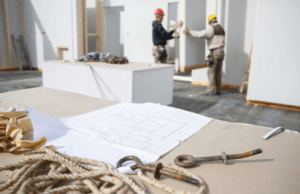Modular Vs. Prefab: What's the Difference?
Although the terms ‘modular’ and ‘prefab’ are sometimes used interchangeably, it’s helpful to draw a distinction between them.
Any component of a building that is manufactured in a factory before arrival and installation at the building site is prefabricated — or ‘prefab’ for short. Modular construction is a specific type of prefab construction.
A building could be made entirely of prefabricated components, such as:
• Roof trusses
• Wall panels
• Floor trusses
• Pre-cast concrete foundation walls and slabs
• Staircases, elevators, etc.
• Bathroom or kitchen modules
• Structural modules
Prefab components can be made of different materials, including wood, steel, and concrete. Some of these components can be more or less finished before being transported to the site and installed. For example, wall panels could be ‘open’ — arriving on-site without insulation, vapor control layers, or external cladding. Or they could arrive at the building site complete with insulation, vapor control, windows, doors, electrical wiring, ducting, and cladding.
Modules are a specific kind of prefab component that enclose space — such as an entire room. This contrasts with ‘flat’ prefab components like wall panels and roof trusses that don’t enclose space. Because they enclose space, modules are also referred to as 3D or volumetric. Entire modules are built in a factory and then delivered to the site for installation.
According to a 2019 article in the journal, Engineering Structures, “[M]odular buildings made from volumetric modules are approximately 42% of the prefabricated building industry in North America.”
At the building site, modules are lifted and stacked by a crane and bolted together to create the building. Then the building is completed by hooking up the MEP (mechanical, electrical, plumbing) systems, perhaps finishing hallways left between modules and adding exterior cladding. Alternatively, there could be separate hallway modules delivered too, or modules delivered with exterior cladding already installed. The level of completion of the modules, and how much on-site work is required varies.
Combining modular and conventional construction
A building may be constructed entirely of modules, or it may have an element of conventional construction as well. For example, a hotel might have its ground level floor constructed on-site — with a spacious lobby, restaurant, and pool area, for example. These large areas may be difficult or impossible to manufacture in a factory and to transport by road to the site. Individual guest room modules could be stacked on top of that site-built floor.
The guest room modules might be complete on the inside — including the carpeting, furniture, bathroom fixtures, even the artwork on the walls! In which case, they just need to be stacked in place, attached to the rest of the building, and the MEP hookups completed.
Another way of combining conventional construction and modular construction is for a building to be mostly site-built, but to include modular elements like bathroom or kitchen pods, or elevator hoistways.
Permanent or relocatable modular construction
Modules, and the buildings made from them, can be permanent or relocatable. Relocatable structures are familiar to most people from temporary school buildings and worksite accommodation. Permanent modular construction (PMC) may be less familiar — especially in North America — but it’s gaining ground.
The 2019 Engineering Structures article mentioned above says that, in North America, 3% of new commercial construction is modular and this is expected to increase to 5% by 2022. In Australia, modular construction is expected to increase from 3% to 5-10% in 2030. As well as modular construction being used in commercial, industrial, healthcare, and educational sectors, the authors conclude that:
“Prefabricated modular buildings will lead to the next generation of housing.”
---------------------------------
Zena Ryder is a Freelance Construction and Healthcare Writer. You can find her at Boudica Writing.
This is an online exclusive article.
